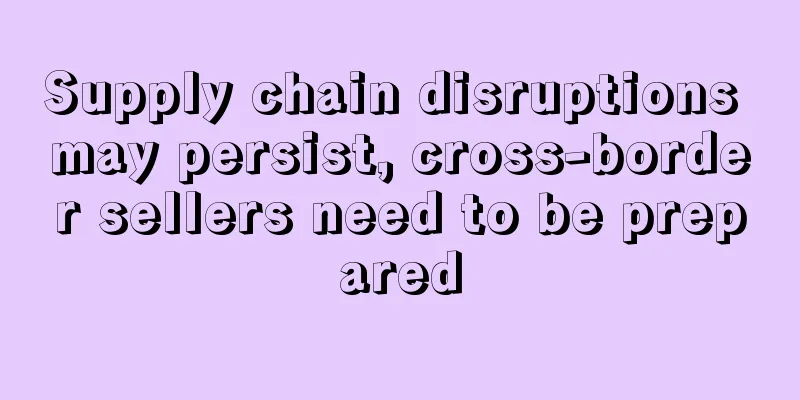Supply chain disruptions may persist, cross-border sellers need to be prepared

|
As we enter the second quarter of 2022, cross-border e-commerce sellers continue to be affected by supply chain disruptions caused by the epidemic, war, and inflation. According to Web Retailer's interviews with some top supply chain experts, this state of supply chain uncertainty will be a "new normal."
For retailers and cross-border sellers, the pressure of supply chain disruptions has led to a series of problems, such as reduced profits, increased transportation and warehousing costs, more buyers dissatisfied with delayed delivery times, and increased difficulties in shipping to overseas warehouses.
When it comes to the initial reason why cross-border e-commerce is in trouble in the supply chain, it is still the global outbreak of COVID-19. With the blockade of various countries, the outbreak of the epidemic has caused a domino effect:
COVID-19 lockdown > Increased e-commerce sales > Shortage of containers > Shipment delays > Congested ports > Shortage of dock workers > Shortage of truck drivers > Shortage of distribution warehouse space > Increased distribution and storage costs > Shortage of delivery drivers > Delayed deliveries > Unsatisfied customers > Reduced revenues for sellers and retailers > Increased prices by sellers, retailers and suppliers > Inflation.
At present, although the pace of the fall of dominoes related to the epidemic has slowed down, it is clear that some of them will not be reset to their normal positions, while others are in an "irregular" state of change.
However, just as the impact of the pandemic began to abate globally, the outbreak of the Russian-Ukrainian conflict set the second set of dominoes in motion. This time, rising fuel costs, economic sanctions against Russia, transportation resources for humanitarian or military needs, currency fluctuations and changes, etc., continue to weigh on the moving parts of the supply chain.
In addition, the impending port strike on the West Coast of the United States, potential U.S. legislation to harm e-commerce, and the uncertain outcome of the ongoing war have all had an impact on sales for cross-border sellers.
For cross-border sellers and retailers, what can they do to maintain their e-commerce business under such circumstances?
1. Place your order early. 2. To offset the adverse effects of longer delivery times, increase order volume. 3. Reduce reliance on just-in-time delivery. 4. Find alternative suppliers and sources of goods. 5. Consider hiring a supply chain expert to handle management of supply chain and logistics issues.
Judging from the current situation, it may take a year or more for the supply chain to stabilize, or it may never stabilize. But consumers' demand for online shopping and home delivery will continue to increase. The best thing sellers can do is to be prepared and flexible. Cross-border sellers Supply Chain The new normal |
>>: South Africa's e-commerce transactions to exceed $27.2 billion in 2025
Recommend
What is burlapandbarrel? burlapandbarrel Review, Features
burlapandbarrel is a spice importer. About burlapa...
The US second-hand market value reaches 35 billion US dollars! Poshmark has a poor outlook
Poshmark has beaten analysts’ revenue expectation...
What is Muli International (Muli Warehousing and Logistics)? Muli International (Muli Warehousing and Logistics) Review, Features
Muli International (Muli (Shanghai) International ...
What is JJ's House? JJ's House Review, Features
Founded in 2007, JJ's House is a leading globa...
The epidemic has created new demands, and this new type of air conditioner is more popular among Indian consumers
As the new coronavirus spreads in India, Indian p...
The growth rate exceeds 100%, and the market size reaches 300 million US dollars! Cycling boom breaks out in Southeast Asia
Affected by the epidemic, the demand for outdoor ...
What is TestBird? TestBird Review, Features
TestBird is a mobile application automation testi...
Panasonic acquires Blue Yonder platform for $7.1 billion
Panasonic, a global electronics and technology gi...
What is SellerRunning? SellerRunning Review, Features
<span data-docs-delta="[[20,{"gallery"...
What is Instabox? Instabox Review, Features
Instabox was founded in Sweden in 2015 and operate...
Will you be banned even if you submit to QA? Many Amazon sellers have been affected
Just as sellers were gearing up for the peak seas...
What is Furui Business? Furui Business Review, Features
Furui Business is a business management company fo...
TikTok’s summer “hot” list is here, and these products are a blast!
As the saying goes, "70% depends on product ...
The best-selling Ice and Fire in 2021: Some people’s net profit was cut by 300 million, and some companies turned losses into profits!
Recently, many major retailers have released thei...
What is Amachete
Amachete is a handy Chrome extension that provide...









